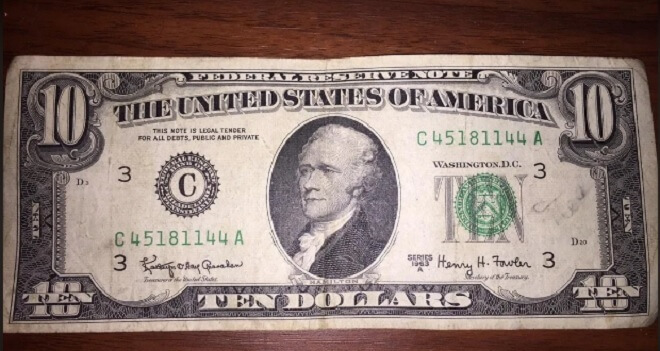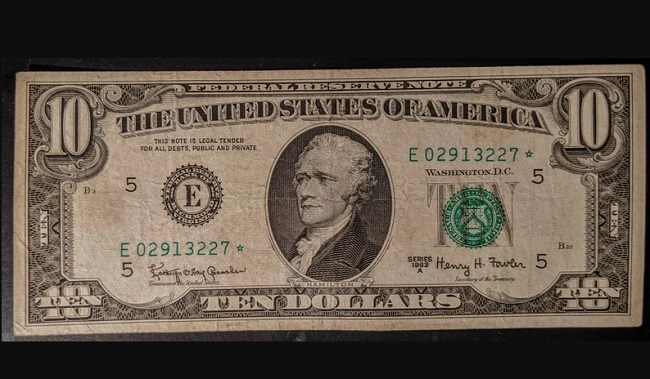1963 10 Dollar Bill Value – Do you have an old 1963 10-dollar bill tucked away somewhere in your house? If so, you may be sitting on a goldmine without even realizing it.
The value of the 1963 10-dollar bill can vary depending on its condition and any unique features it may have, such as misprints or rare serial numbers.
In this blog post, we will explore the potential worth of this particular bill and how to determine its value.
So, dust off that old bill, and let’s find out if you have a valuable piece of history in your possession.

History Of The 10 Dollar Bill
Well, the truth is that the 1963 ten-dollar bill is not a rare or valuable bill in most cases. Most of these bills will not be worth much more than face value.
However, there are star note varieties that sell for more money. Star notes are replacement bills that the United States Federal Reserve printed.
These star notes are more rare and thus more valuable. You can tell if you have a star note by looking to see if there is a star symbol at the end of the serial number.
Now, let’s dive into the history and overview of the 1963 10-dollar bill.
Every $10 bill features Alexander Hamilton on the front. Hamilton was never president, but he did serve as the nation’s first Secretary of the Treasury.
Today, every $10 bill is a Federal Reserve note. However, in the past, there were also legal tender notes, silver certificates, and gold certificates.
In addition, there were different-sized bills. Every bill printed before 1928 was a large-size bill. The current small-size bills were first issued for the 1928 series.
1963 $10 Dollar Bill Specifications
The denomination is $10.00 USD, and it is a Federal Reserve Note.
The seal on the bill is one variety, which is green. There are two series varieties for the bill: 1963 and 1963A.
It’s worth noting that if your 1963 10-dollar bill has a star symbol at the end of the serial number, it is a star note.
Star notes are replacement bills that the United States Federal Reserve printed, and they are more rare and valuable.
So, if you have a 1963 10-dollar bill with a star, it could be worth more than its face value.
1963 Ten Dollar Bill Value
Let’s talk about the value of your 1963 ten-dollar bill. Now, if your bill is in circulated condition, it’s likely only worth its face value of $10.
However, if you have a bill in extremely fine condition or better, you might be able to sell it for a premium. And if your bill happens to be a star note, that’s even better!
So, let’s break it down.

The 1963 series $10 bills in extremely fine condition are worth around $15. But if you have one in uncirculated condition with a grade of MS 63, you can expect to get anywhere from $50 to $62.50.
Now, let’s talk about the 1963A series $10 bills.
These are also worth around $15 in extremely fine condition. And if you have an uncirculated bill with an MS 63 grade, you can expect to get around $35.
But here’s the catch – if your bill was issued from the Federal Reserve Bank of Minneapolis, it could be worth even more!
Star notes are more rare and valuable, so they can fetch a higher price in the market.
1963 Ten Dollar Bill Star Notes
Did you know that some of your 1963 10-dollar bills could be worth more than face value? That’s right, if you have a bill with a star symbol at the end of the serial number, you might have a star note.
Star notes are replacement bills that the United States Federal Reserve printed, and they are more rare and valuable than regular bills.
The 1963 series $10 star notes are worth around $37.50-70 in extremely fine condition. If you have one in uncirculated condition with a grade of MS 63, you can expect to get around $100-125.
These prices can vary depending on the market and demand, but star notes are generally worth more than regular bills.
The 1963A series $10 star notes are also valuable, with prices ranging from $27.50 30 in extremely fine condition. If you have an uncirculated note with an MS 63 grade, you could get around $65-80 for it.
And if your star note was issued from the Federal Reserve Banks of St. Louis or Minneapolis, it could be worth even more.
1963 Ten Dollar Bill Grading System
How to determine the condition of your 1963 10-dollar bill, let’s take a look at the grading system.
A note in extremely fine condition will show small signs of having been in circulation, but it will still be bright and retain most of its original crispness.
There might be one or two minor creases or folds, but there are no stains, discolorations, or tears.
On the other hand, an MS 63 choice uncirculated note shows no signs of ever having been in circulation. It will still have its original crispness and will be well-centered.
Why A 1963 10 Bill Is Worth A Lot Of Money
There are a few reasons why these bills are valuable.
- They were the last paper bills made with silver, which makes them valuable to collectors.
- There are very few 1963 10-dollar bills in circulation because most were destroyed when the government switched to making bills with copper. This rarity makes them rare and valuable.
- These bills are over 50 years old, which adds to their collectible value.
Note that the values may vary depending on factors such as grade and issuing bank.
Is a 1963 10 bill worth anything?
Unfortunately, the answer is not really. The 1963 ten-dollar bill is not considered a rare or valuable bill, so it won’t fetch much more than its face value. However, there is a small glimmer of hope.
If you happen to have a bill with a star symbol at the end of the serial number, it could be a star note.
Star notes are replacement bills that the United States Federal Reserve printed, and they are more rare and valuable than regular bills.
So, if you have a 1963 10-dollar bill with a star, it’s worth investigating further. But without the star, most of these bills won’t be worth much.
How to Sell Your 1963 Ten-Dollar Bill at the Best Price
So, you’ve determined the potential value of your 1963 ten-dollar bill, and now you’re ready to sell it. But how do you ensure you get the best price? Here are a few tips to help you out.
- Do your research. Look into current market trends and see what similar bills are selling for. This will give you an idea of what to expect in terms of price. Additionally, consider reaching out to experts or collectors who specialize in currency. They can provide valuable insights and advice on selling your bill.
- Take good-quality photos of your bill. Clear, detailed images will help potential buyers get a better idea of its condition. Be sure to highlight any unique features, such as misprints or the star symbol for star notes.
- When listing your bill for sale, be honest and transparent about its condition. Provide a thorough description, including any flaws or imperfections. This will help manage expectations and build trust with potential buyers.
- Consider selling your bill through reputable online marketplaces or auction websites. These platforms provide a wider audience and give you the opportunity to reach collectors from all over the world. Be sure to set a fair price that reflects the bill’s condition and rarity.
- Be patient. Selling valuable items can take time, so don’t rush the process. Wait for the right buyer who values your bill and is willing to pay a fair price.
Conclusion
So, there you have it! The 1963 10-dollar bill may not be the most valuable or rare piece of currency, but it’s still worth investigating. Most of these bills won’t be worth much more than face value, there is a chance that you could have a valuable star note with that coveted star symbol at the end of the serial number.
Star notes are more rare and valuable, so they can fetch a higher price in the market. If you’re lucky enough to have a star note, make sure to check its condition and grade to determine its worth.
So, if you have a regular bill or a star note, don’t forget to do your research, consult experts, and take good quality photos when selling your 1963 10-dollar bill. Happy hunting for that hidden treasure!